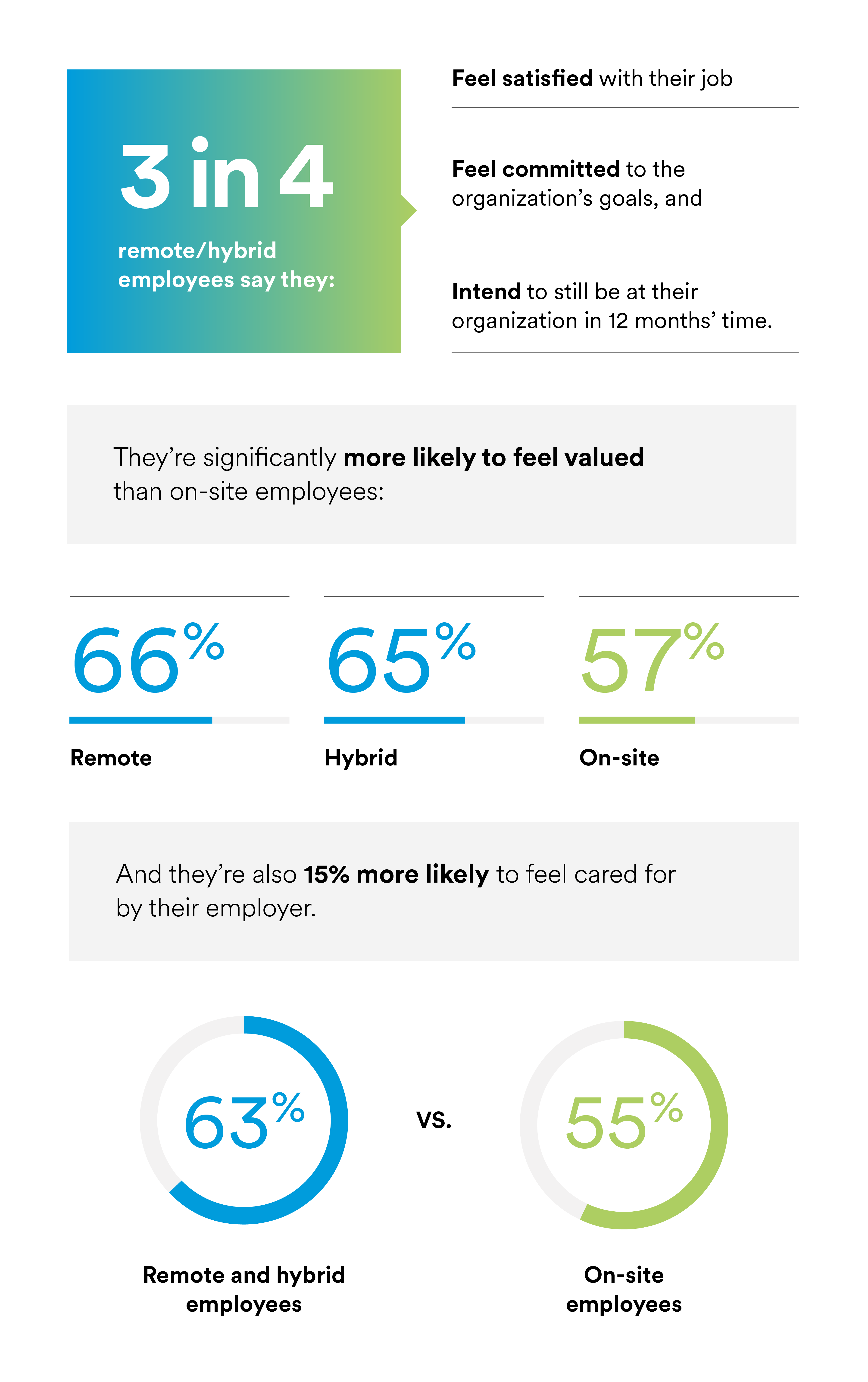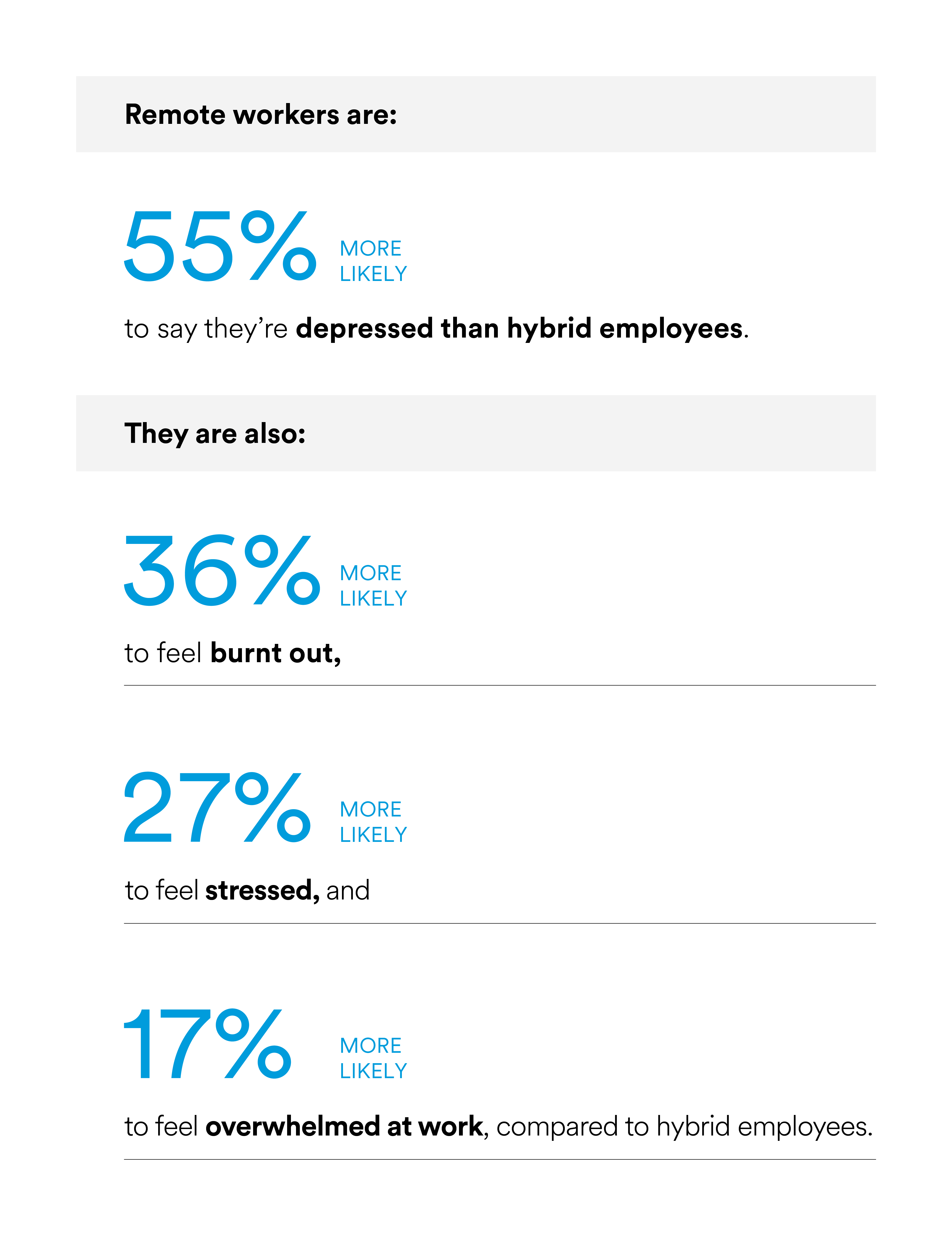Offering Hybrid and Remote Work
How employee care can support the hybrid workforce
Key takeaways:
- Offering hybrid and remote work offers several advantages, including greater job satisfaction, engagement, and loyalty.
- However, fully remote work comes with challenges that can impact employees’ mental health.
- Employers have an opportunity to create a “remote-friendly” culture of support via empathic leadership training, as well as by empowering employees to use their mental health benefits.
The COVID-19 pandemic, and the shift to remote work that came with it, permanently transformed the workplace. Post-pandemic, a far greater proportion of workers have the flexibility to choose their work location. One in four U.S. workers are now fully remote, and an additional 20% have a hybrid work arrangement.
For many remote workers, this flexibility has served them well. Nearly four in five remote and hybrid workers say they prefer working remotely or at home. They’re able to work more productively, spend less of their personal time commuting, and save money on the expense of travelling to work.
And, by providing the option to work remotely, employers have improved organization-wide outcomes, too:

Three in four remote/hybrid employees feel satisfied with their job, committed to the organization’s goals, and intend to still be at their organization in 12 months’ time. They are more likely to feel valued, when compared to on-site employees and are 15% more likely to report feeling cared for by their employer.
However, remote work can impact employees’ mental health
While the option to work remotely brings with it plenty of advantages, bringing the workplace home can have ripple effects on employees’ mental well-being. Put simply, fully remote work can feel lonely — and working in a silo may impact employees’ ability to communicate and build relationships with their colleagues.
Perhaps not surprisingly, then, our research has uncovered a sharp contrast between remote and hybrid workers when it comes to mental well-being:

Remote workers are 55% more likely than hybrid workers to say they’re depressed. They are also 36% more likely to report feeling burnt out, 27% more likely to feel stressed, and 17% more likely to feel overwhelmed at work, compared to hybrid employees.
Remote employees also rate lower than hybrid or on-site employees when it comes to aspects of psychological safety. While the vast majority of remote workers — three in four — still say they feel psychologically safe at work, they’re still significantly less likely than hybrid or on-site workers to feel secure in their jobs or feel they can speak their mind freely without judgement.
Employers have an opportunity to bolster workers’ psychological safety with employee care
Employers have an opportunity to help their employees reap the benefits of remote work — and mitigate the potential downsides — by demonstrating employee care.
“Employee care” refers to employers’ genuine demonstration of interest in employees’ overall well-being, both at work and outside of work. It layers five elements of the employee experience — purposeful work, a social & supportive culture, flexibility & work-life balance, professional growth & training, and wellness programs & benefits — on a foundation of fair compensation to cultivate the engaging employee experience that top talent expects.

The elements of employee care are purposeful work, a social and supportive culture, flexibility/work-life balance, professional growth/training, wellness programs/benefits, and pay/compensation, which is foundational.
Demonstrating care allows employers to boost employees’ psychological safety by helping each team member feel safe, valued and welcome at work. It also drives greater holistic well-being, supporting employees’ mental, physical, financial and social health.
As a result, employees feel empowered to bring their best performance to work — and employers realize greater organization-wide outcomes, including higher productivity, satisfaction and loyalty.
Demonstrating care across the remote and hybrid employee experience
These three strategies can enhance workers’ psychological safety and mental well-being.
1. Deploy listening mechanisms to more deeply understand the needs of a hybrid workforce
Building a social and support culture starts with putting employees’ needs first, including the unique needs of remote and hybrid employees.
And, although two-thirds of hybrid and remote workers say they’re satisfied with their organization’s culture, that means one in three are not. As a result, employers have an opportunity to boost outcomes by extending the organization’s culture beyond the four walls of the workplace.
Employers should proactively reach out to remote and hybrid employees to see which aspects of the workplace culture resonate most, which aspects could be improved, and the steps management could take to better support the remote workforce. Allow employees to respond anonymously — for example, by using a third-party survey tool that allows anonymous submissions — so remote employees can feel psychologically safe providing honest feedback.
2. Invest in career development and training, including empathic leadership training
Helping employees forge a path forward at your organization doesn’t just support retention, it also has the potential to enhance workers’ psychological safety.
However, today’s remote employees say they crave more training and development opportunities than they’re currently receiving, which may explain why these workers are significantly less likely to feel secure in their jobs than their hybrid and on-site colleagues.
Employers can adapt by broadening their career development opportunities with the needs of remote workers in mind, such as offering online training and webinars. When possible, employers should consider matching remote employees with a hybrid mentor who can speak to the challenges of working remotely, while also providing a link to the organization’s in-office culture.
Finally, employers should invest in empathic leadership training to help managers cultivate a supportive workplace that helps remote employees feel psychologically safe. Training managers to actively solicit honest feedback — and provide supportive feedback in return — can help remote employees feel heard. It also broadens the mix of career development opportunities available within the organization to keep each employee engaged in their work.
3. Support employees’ mental health with wellness programs and benefits
Wellness programs and benefits are a central element of the employee experience — and mental health benefits, in particular, can help remote employees thrive. Employers should offer access to a range of mental health benefits, including benefits that help workers access mental health care in-person or remotely.
Employers should pair these efforts with benefits communications that empower remote and hybrid employees to get the most from their benefits. Tailored communications could discuss the risk of loneliness and depression with remote work arrangements, for example, then highlight the mental health benefits available to help.
Future-proofing your workforce with employee care
“Work from anywhere” is here to stay, and employers must adapt in order to attract and retain their talent. Deeply understanding the unique needs of today’s remote and hybrid workforce allows employers to create a nurturing, supportive workplace culture that helps every employee feel cared for.
